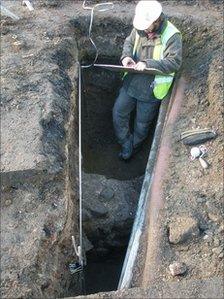Boundary wall from 1600s found at Edinburgh castle
- Published

The site of the 17th Century wall has now been refilled
Excavations for the new Tattoo stands on Edinburgh Castle esplanade have revealed the remains of a boundary wall dating back to the 17th Century.
CFA Archaeology will now look at the surrounding area to gain a clearer understanding of what it was part of.
A trench dug for one of more than 100 concrete pad foundations for the new stands revealed the remains of a wall around 1m (3.3ft) wide.
The works are part of a Scheduled Monument Consent granted by ministers.
Last year the team found the foundations of the artillery bastion, known as the spur, that formed part of the outer defences dating to the 1540s.
Fiona Hyslop MSP, Minister for Culture and External Affairs, said: "It is very exciting that this work to accommodate the new Tattoo stands is revealing previously unknown aspects of one of Scotland's most iconic sites.
"The history of Edinburgh Castle captivates millions of visitors and it is incredible to think that we are still able to discover new information that will improve our understanding of it."
Peter Yeoman, Historic Scotland's head of cultural resources, said the approach to the castle before the 1700s was very different.
'Majestic' castle
"It was far steeper and narrower with the castle dominating the skyline," Mr Yeoman said.
"The spur we found last year stretched about two thirds of the way down the esplanade and this wall is beyond that.
"There are early plans which we think show the newly discovered boundary wall beside the old approach to the castle.
"Thanks to these excavations our knowledge of the construction of the esplanade is much better informed, really bringing home just how steep an incline it would have been and how majestic the castle would have appeared rising up from the rock face."
The esplanade was formed in 1753 to create a parade ground for the military.
As part of the process, large amounts of levelling was deposited on the area immediately in front of the castle, covering up earlier buildings.
The site of the wall has now been refilled as the excavations continue in other areas of the esplanade.
- Published25 October 2010
- Published22 September 2010
- Published6 August 2010